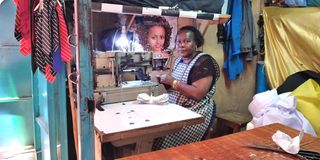
Mrs Wangeshi Waithaka prepares her stitching machine for sewing school uniforms as well as masks at her stall in Uhuru Market, off Jogoo Road, Nairobi County.
What you need to know:
- This is the first of such markets in the region to put in place measures to ensure adoption of technology in their supply chain.
- Heva is an East African fund that invests in social and economic potential of the creative economy sector.
- In the long term, the project aims to enable wholesale production of uniforms for various sectors.
Rehabilitation of Uhuru Market, off Jogoo Road in Nairobi County, has started. The 44-year-old facility is being upgraded to a centre of excellence.
The project, spearheaded by the national government and HEVA Fund, has seen more than 1,000 traders at the centre that is popular for clothes stitching undergo training to enhance their fashion and apparel production skills.
This is the first of such markets in the region to put in place measures to ensure adoption of technology in their supply chain.
HEVA Fund Managing Partner George Gacharia said the aim of the rehabilitation project is to enable micro, small and medium-size fashion and apparel producers and retailers address constraints of the garment and textile value chain.
Affordable clothing
Heva is an East African fund that invests in social and economic potential of the creative economy sector.
“Traders will be supported on the role of supplying affordable clothing to Kenyans of all walks of life, and providing gainful, decent and sustainable employment to the citizens of this community,” said Mr Gacharia.
This is by opening up avenues for increased investment and support to players, leading to industry growth, decent work and sustainable employment.
Mr Gacharia said traders face numerous challenges including limited and unsustainable market access, competition from other structured local private manufacturers and operational challenges as well as limited access to credit facilities through SME funds, credit guarantees and LPO financing from banks.
Capacity building
The market established in 1976 houses more than 1,000 traders operating in 567 stalls with average age of 29 years and the main activity being the production of textile products where school uniforms are the most popular product in the market.
Mr Gacharia said the immediate aim of the project is capacity building through training in new ways of production as well as digital skills.
In the long term, the project aims to enable wholesale production of uniforms for various sectors.
Last week, a section of the traders were taken through a three-day beginner’s technical skills course on bag design and construction, garment design and construction and quality control.
comulo@ke.nationmedia.com





No comments :
Post a Comment